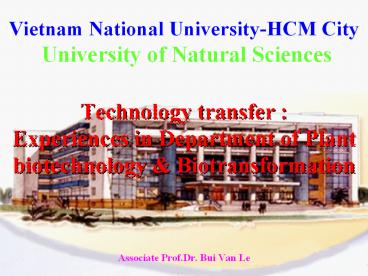Vietnam National University-HCM City University of Natural Sciences - PowerPoint PPT Presentation
1 / 22
Title:
Vietnam National University-HCM City University of Natural Sciences
Description:
Transformation in plant using Agrobacterium tumefaciens and biolistic methods. . Transgenic plants in laboratory (e.g. Tobacco, Citrus, Cassava, Vetiver). . – PowerPoint PPT presentation
Number of Views:105
Avg rating:3.0/5.0
Title: Vietnam National University-HCM City University of Natural Sciences
1
Vietnam National University-HCM City University
of Natural Sciences
- Technology transfer Experiences in Department
of Plant biotechnology Biotransformation - Associate Prof.Dr. Bui Van Le
2
Outline of presentation
- Introduction
- Current researches in plant biotechnology
- Results in technology transfer
- Some successful examples in technology transfer
- Conclusions
3
Introduction
- General researches of Universities
- Basic scientists often make remarkable
discoveries. - Fundamental researches.
- Many Universities have made researches under
governmental finance. - Lack of the co-operation with Industry.
4
- Some Universities have technology transfer
programs - - Research can directly benefit the public.
- - Facilitating the commercialization of research
results for the public. - Faculties have come to expect support for
patenting and started businesses. - Some Universities make lots of money.
5
What are we doing now in plant Biotechnology?
- Develop methods of Tissue culture for mass
propagation of plant and metabolite secondary
productions. - Develop methods of gene transfer in plant to
monitor the dispersal of transgenic plants. - Utilize marker molecular to monitor plant
resources and plant diseases.
6
Results in plant tissue culture
- . Basic researches on model plants such as
tobacco, Arabidopsis to study morphological
program of plant cells using Thin Cell layers
technique. - . Mass propagation of plants (e.g. Paulownia,
Pinus carribea, Vetiver Zizanoids, Orchids,
Saintpaulia..). - . Producing in vitro secondary metabolite
compounds (e.g. Naphthoquinone in Drosera burmani
Vahl). - ? Exploitation of plant propagation and
natural product.
7
Results in plant transformation
- . Transformation in plant using Agrobacterium
tumefaciens and biolistic methods. - . Transgenic plants in laboratory (e.g. Tobacco,
Citrus, Cassava, Vetiver). - . Develop some methods (PCR, Real time PCR) to
detect transgenic plants based on target genes,
promoter (CAMV35S) and terminator (tNOS) - ?Exploitation of detection transgenic plants in
crop plants and food.
8
Results in plant resources
- . Identification plant sources using maker
molecular techniques such as RAPD (e.g. tomato,
bananas) - . Detection plant diseases using PCR technique
(e.g. Phytophthora infectans in tomato .) - . Study hybridization between species to obtain
novel varieties (e.g. orchids) - ? Exploitation of plant breeding project and
detection plant diseases.
9
Why do we use Technology Transfer Programs?
- The processes of laboratory researches are
transferred to organizations for development and
commercialization. - Extend the parameters of technological innovation
by using fundamental knowledge through focusing
applied research and development. - - Participate in the establishment of technology
and business.
10
Barriers
- . Lack of highly professional management and
mechanism of supporting . - . Lack of appropriate resources to approach
up-date information and find out the
opportunities for technology cooperation. - . Short term of production.
11
Some successful examples in technology transfer
- Technology transfer in Saintpaulia ionantha.
- Technology transfer in orchids.
- Technology transfer in molecular methods.
12
In case of study in Saintpaulia species.
- Technological issues
- Produced in the world.
- Little information about technological
productions (only by cutting). - Research issues
- Educational programs (plant tissue culture).
- Facilities for mass propagation.
- Effective applications of the process
- Novel plants.
- Cycle productions 4-5 months.
13
Technology transfer strategies for Saintpaulia
- The establishment of plant tissue culture system
about the innovation and technology transfer for
students - Integrating education and RD programs
- The development of appropriate innovations,
technology transfer models and support systems
14
Results in Saintpaulia ionantha
- Produce 75.000 plants in 3 years.
- Transfer technique in local sectors.
15
In case of study in orchids.
- Technological issue
- Produced in the world.
- Much information about technological productions
(by tissue culture). - Research issue.
- Research programs (tissue culture).
- Effective application of process.
- Low technical capability.
- Cycle productions 1-5 years.
16
Technology transfer strategies for orchids
- Combination with individual organizations for
Innovation and Technology Transfer. - The development of appropriate innovations,
technology transfer models and support systems.
17
Results in technology transfer for orchids
- Produce 100.000 plants in 2 years
18
In case of study in plant marker molecular
- Technological issue
- Useful techniques in the world.
- Much information about technique.
- Research issue.
- Research programs.
- Effective application of the process.
- Highly technical capability.
- Fast detections.
19
Technology transfer strategies for plant marker
molecular
- Exchange experiences, models and the best
practices through networks. - Standardization Innovation and Technology
Transfer.
20
Results in technology transfer for plant marker
molecular
- Methods of detection plant diseases.
- Methods of detection GMOs.
- Methods of identification plant breeding.
21
CONCLUSIONS
- Results of researches in universities start the
technology transfer processes. - Enhancement RD program at Universities.
- Its necessary to have a support mechanism for
technology transfer. - Universities play professionally consultative
role.
22
Thank you for your attention!




























![Hidayatullah National Law University - [HNLU], Abhanpur PowerPoint PPT Presentation](https://s3.amazonaws.com/images.powershow.com/9656989.th0.jpg?_=20210906015)
![Barkatullah University - [BU], Bhopal PowerPoint PPT Presentation](https://s3.amazonaws.com/images.powershow.com/9665873.th0.jpg?_=20210928011)

